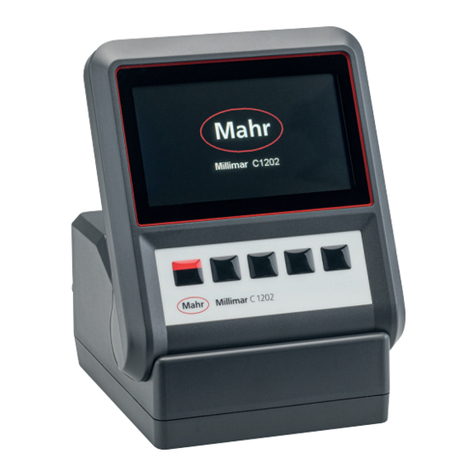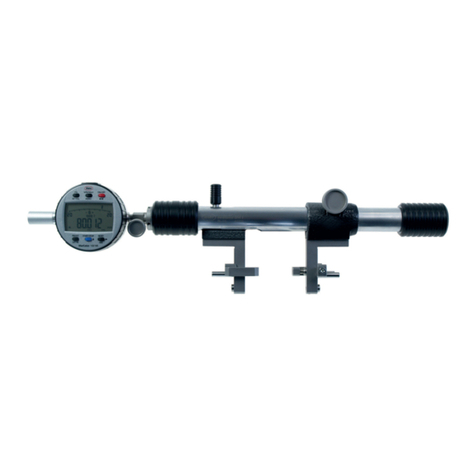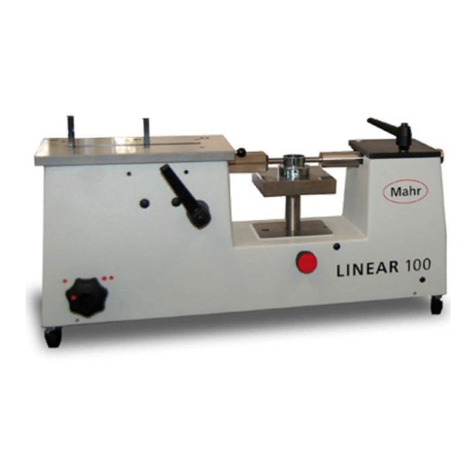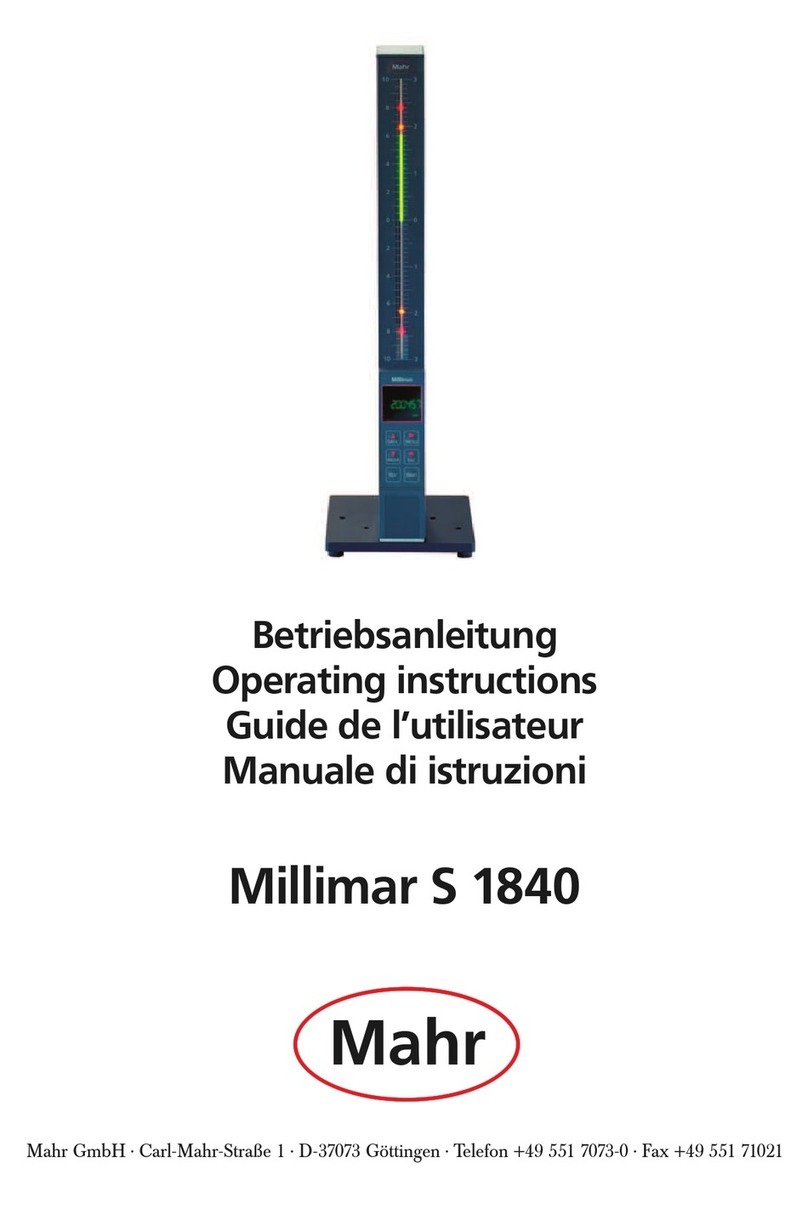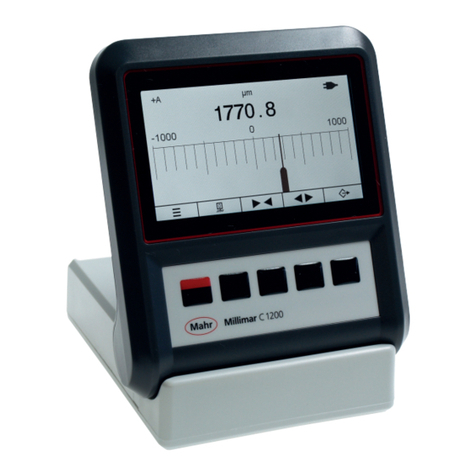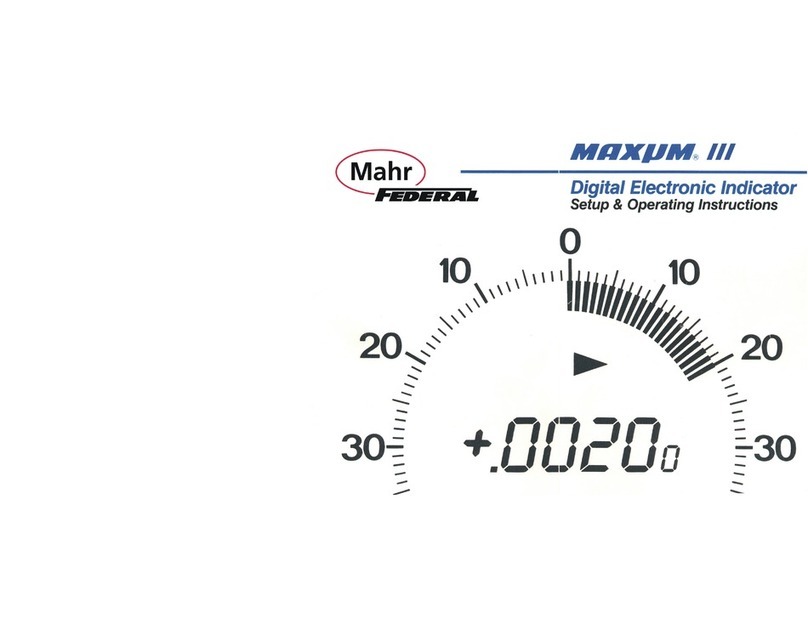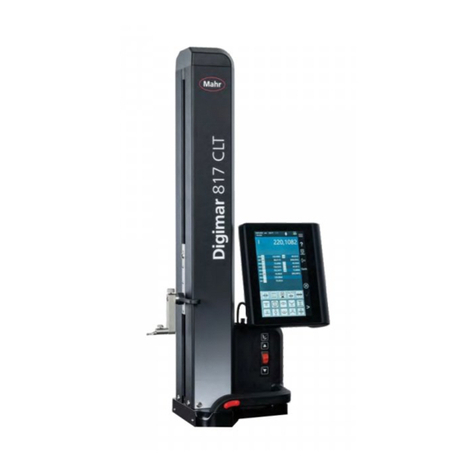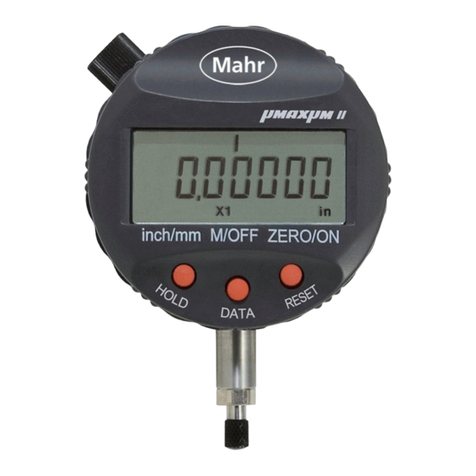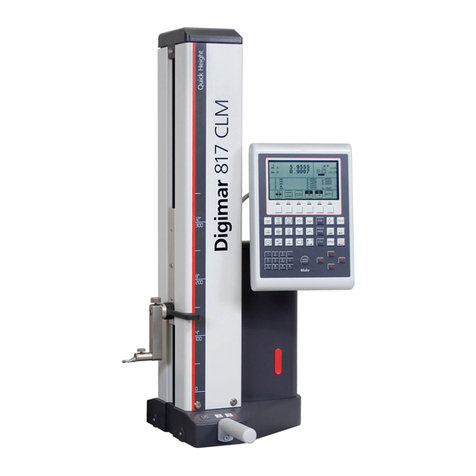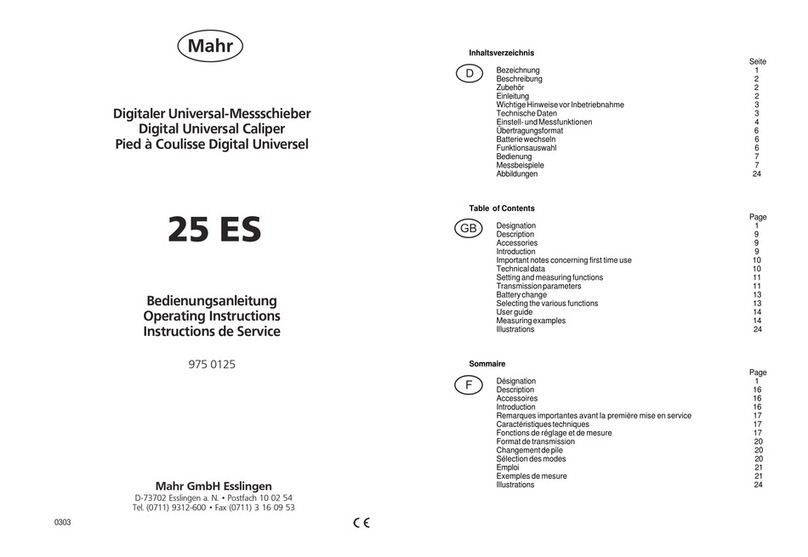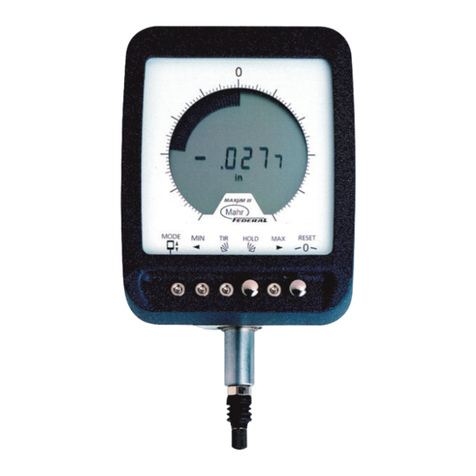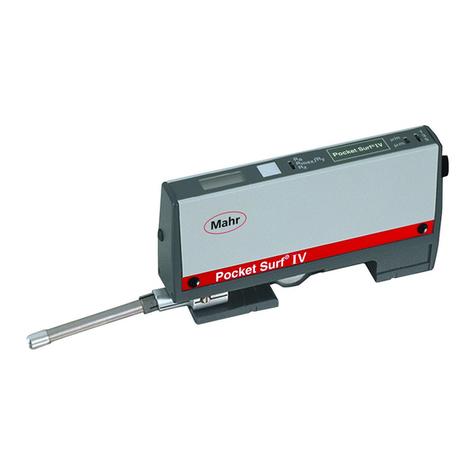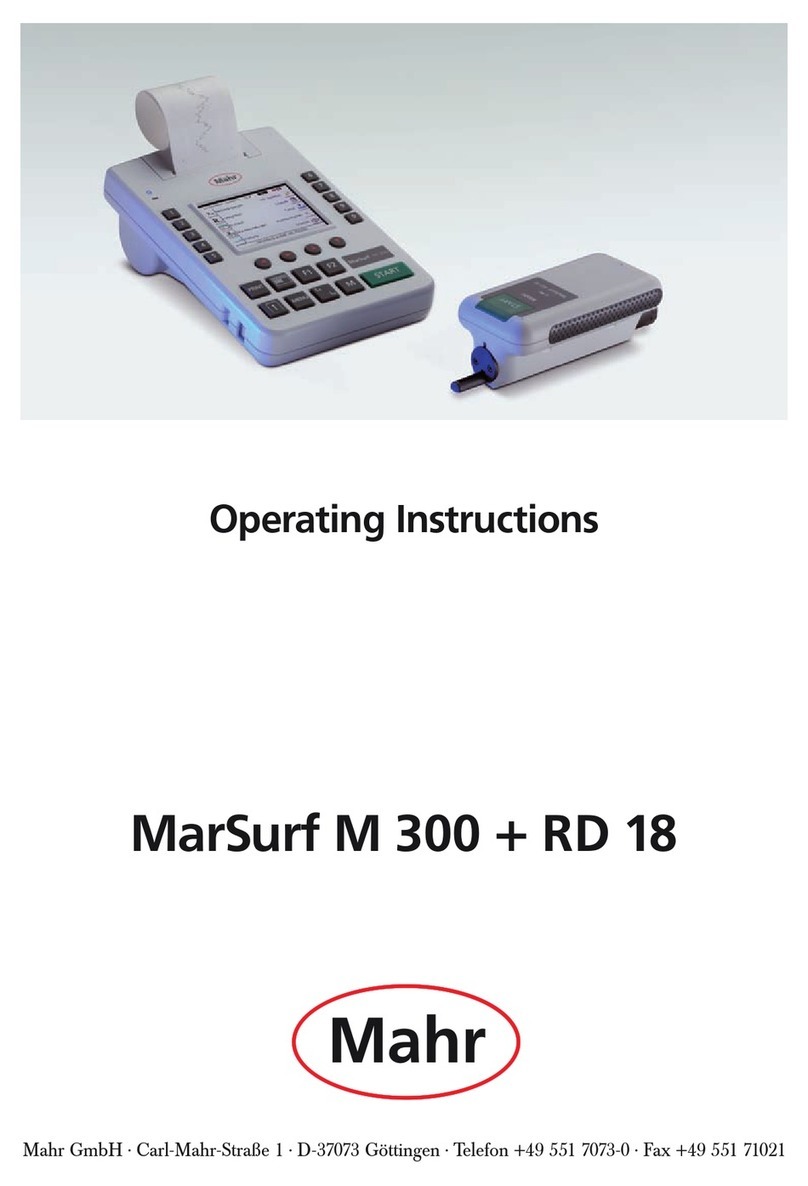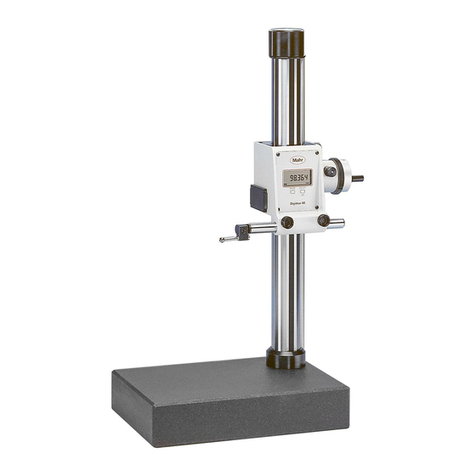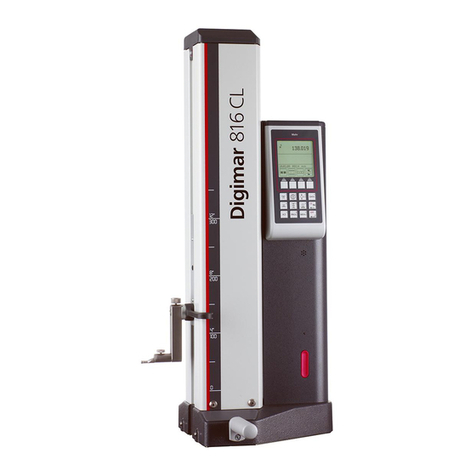
Printed in Germany
0605
Bedienungsanleitung
Operating Instructions
Instructions de Service
Bügelmessschraube
Micrometer
Micrométre
40 AG/W
Mahr GmbH Esslingen
D-73702 Esslingen • Postfach 10 02 54
Telefon (07 11) 9 31 26 00 • Fax (07 11) 3 16 09 53
3758429
Beschreibung
1 Schnelltrieb
2 Messtrommel mit integrierter Ratsche
3 Hülse
4 Messspindel
5 Einstellmutter
6 Feststelleinrichtung
7 Bügel
8 Messflächen
9 Amboss
10 Hakenschlüssel
F
D
USA
GB
F
D
USA
GB
Justieren der Nullstellung
Einstellen auf Null
– Messflächen reinigen
– Messspindel 4mit Messtrommel 2unter Einsatz der
Ratsche an Amboss 9oder Einstellmaß anlegen
– Abweichung des Null-Striches der Messtrommel 2
gegenüber der Null-Linie der Hülse 3feststellen
– Messspindel 4einige Umdrehungen zurückschrauben
– Mit Hakenschlüssel 10 die Hülse 3um die festgestellte
Abweichung drehen.
– Zur Prüfung Messspindel 4mit Schnelltrieb 1an
Amboss 9oder Einstellmaß anlegen und Übereinstim-
mung von Null-Linie der Messhülse mit Null-Strich der
Messtrommel prüfen. Bei noch vorhandener Differenz
Nachstellung verbessern.
Hinweis:
Nach mehrmaligem Nachstellen kann die Null-Linie der
Messhülse in eine ungünstige Messstellung kommen.
– Messhülse in die günstigste Stellung zurück drehen und
die genaue Einstellung an der Messtrommel vornehmen.
– Schnelltrieb lösen; Messtrommel durch mäßiges Klopfen
mit einem Holz lockern und in die richtige Stellung bringen.
Nachstellen bei Spindelspiel
– Spindel mit Messtrommel herausschrauben. Lage der
Feststelleinrichtung 6nicht verändern.
– Die Einstellmutter 5geringfügig lösen, bis der erforder-
liche spielfreie Gang der Messspindel 4 erreicht ist.
– Messspindel wieder in den Schaft einführen und
vorsichtig einschrauben. Achtung! Gewindegänge
dabei nicht beschädigen.
– Nullstellung kontrollieren und gegebenenfalls auf Null
einstellen.
Adjusting the zero position
Setting to zero
– Clean measuring faces
– Turn thimble 2 using the ratchet until the measuring
spindle 4makes contact with the anvil 9or a setting
standard
– Determine the deviation between the zero line on the
thimble 2and the reference line on the barrel 3
– Unscrew the measuring spindle 4 a few turns
– Apply the hook spanner 10 to the barrel 3and turn to
the previously determined deviation
– Examine whether the reference line on the barrel is
aligned the with the zero line on measuring spindle 4,
turn the measuring spindle using the rapid drive until
contact is made with the anvil 9 or the setting standard,
if necessary this process must be repeated.
Note:
After repeated adjustments the reference line on the barrel
maybe in a inconvenient reading position.
– Reset the barrel to a convenient reading position and
then make the adjustments to the thimble
– Loosen the rapid drive; loosen the thimble by tapping it
with a piece of wood and set in the correct position.
Readjust in case of spindle play
– Unscrew the measuring spindle and thimble, do not
alter the position of the clamping device 6
– Slightly undo the setting nut 5until the point is reached
were the spindle 4is completely free of play
– Return the spindle to its shank and carefully screw it
back into position. Attention! Be extremely cautious
so as not to damage the first threads
– Check the zero position, and if necessary set to zero.
Remise à zéro
Ajustage de la position zéro (fig. c)
– Nettoyer les faces mesurantes
– Utiliser l’avance rapide 1avec tambour 2pour mettre
en contact la vis micrométrique 4avec la touche 9 ou
alors utiliser un étalon de réglage.
– Déterminer la déviation de la ligne « 0 » sur le tambour
2par rapport à la ligne « 0 » du vernier.
– Resserrer la vis micrométrique 4de quelques tours.
– A l’aide de la clef 10 tourner le vernier 3par la
déviation déterminée précédemment.
– Pour contrôler si le « 0 » du vernier est aligné au « 0 »
du tambour 2, tourner la vis micrométrique 4en
utilisant l’avance rapide 1pour en mettre en contact
avec la touche 9ou alors utiliser un étalon de réglage.
En cas de déviation encore existante, il faut répéter le
procédé.
Remarque :
Après des rajustages répétés la ligne de référence sur le
vernier peut être dans une position de lecture inconvéniente.
–Ramener le vernier sur la position la plus convéniente et
procéder à l’ajustage exact sur le tambour
–Desserrer le système d’avance rapide ; frapper très
légèrement avec une pièce de bois sur la roue de fiction
et la mettre dans la position correcte
Rajustage en cas de jeu de la vis micrométrque
–Dévisser la vis micrométrique avec le tambour. Ne pas
changer la position du dispositif de blocage 6.
–Desserrer très légèrement le cône 5jusqu’au point où la
vis micrométrique 4est complètement sans jeu
–Remettre la vis micrométrique dans la queue et la visser
avec précaution dans la position correspondante.
Attention ! Ne pas en endommager les pas des vis.
–Contrôler la position zéro et si nécessaire rajuster au
point zéro.
69 835421
7
10
8
Description
1 Avance rapide
2 Tambour avec bouton à friction
intégré
3 Vernier
4 Vis micrométrique
5 Cône
6 Dispositif de blocage
7 Etrier
8 Faces mesurantes
9 Touche de mesure
10 Clef pour l’étalonnage
Description
1 Rapid drive
2 Thimble with integrated ratchet
3 Barrel
4 Measuring spindle
5 Setting nut
6 Clamping device
7 Frame
8 Measuring faces
9 Anvil
10 Hook spanner

